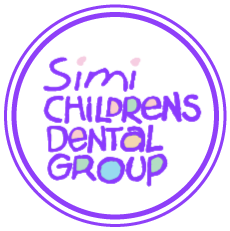Baby's First Teeth
Baby’s First Teeth
Baby teeth are just as important as adult teeth – for chewing, speaking, and appearance. In addition, the baby teeth hold space in the jaws for the adult teeth. Both primary teeth and permanent teeth help give the face its shape and form. People usually think of a newborn baby as having no teeth. But the 20 primary “baby” teeth that will appear in the next two to three years are already in the baby’s jaw at birth. Most of the crowns (tops) of the baby teeth are almost fully developed, and the crown of the six year old molar has begun forming.
Baby Teething Cycle
A baby’s first teeth begin to appear as early as six months after birth. The front two upper and two lower newborn teeth usually appear first. When teething, some babies may have sore or tender gums. Gently rubbing your child’s gums with a clean finger, a small, cool spoon or a wet gauze pad can be soothing. You can also give the baby a clean teething ring to chew on. If your infant is still cranky and uncomfortable, consult your infant dentist or physician. Most children have a full set of 20 baby teeth by the time they are three years old. The adult teeth start to appear at about age six. By the time your child reaches age 21, all 32 of the adult teeth, including the wisdom teeth, will usually have erupted if there is room for them.
Preventing Infant Tooth Decay of Primary Teeth
Babies are at risk of cavities, just like adults and baby tooth decay puts children at higher risk for decay later in life with their adult teeth. That’s why it is so important to consult a pediatric dentist about how to take good care of baby teeth. As soon as baby teeth appear in the mouth, infant tooth decay can occur. Decay can start when a baby’s teeth are in contact with liquids containing sugar for long time periods. The liquids that can cause baby bottle tooth decay include sweetened water and fruit juice, milk, breast milk, and infant formula. Tooth decay can happen when parents or caregivers put a baby to bed with a bottle of any liquid other than water – or use bottles as a pacifier for a fussy baby. Infants should finish their bottles before going to bed. Caregivers should then wipe the baby’s gums with a clean gauze pad or wet washcloth. If you use a pacifier, use a clean one. Never dip a pacifier in sugar or honey before giving it to a baby. Never put the pacifier in your mouth and then in the baby’s mouth. Ask your pediatric physician or infant dentist to recommend a type of pacifier.

Keeping Your Baby's Teeth Healthy
Begin cleaning the newborn baby’s mouth during the first few days after birth. After every feeding, wipe the baby’s gums with a clean gauze pad or wet washcloth. This removes plaque and food left behind that can harm erupting teeth. To clean your baby's teeth, you can sit on a sofa with the infant's head in your lap. Be sure you can see into the baby's mouth easily.
As your child grows and more teeth begin to appear, brush them gently with a child’s size toothbrush and water or fluoride-free toothpaste. After age three, a pea sized amount of fluoride toothpaste can be used for brushing.
If you have concerns, ask your pediatric infant dentist specialist when you should start using a fluoride containing toothpaste for your child. Recommendations can vary due to fluoride content in your local water supply.
First Dental Visit
As soon as your baby's first tooth appears, schedule a first dental visit. The American Academy of Pediatric Dentistry recommends that children should visit the pediatric dentist before their first birthday. Treat the first visit as you would a “well baby” check up with the child’s pediatrician. It’s best to meet the dentist when your child is having no dental problems – don’t wait until an emergency comes up.
Having a “well baby” check up at this age connects your child to a dental home. This is a “home base” for baby dental care, a place where you can take your child from year to year. This helps our infant dentist specialists get to know your child’s and your family’s specific needs, so he or she can provide the best care.
During the first visit, your child's pediatric dentist can do several things, such as:
- Review your child’s health history.
- Perform a complete infant oral care exam to check growth and development, oral hygiene, discuss injuries, cavities and other problems.
- Evaluate your child for risk of developing baby tooth decay.
- Clean the baby teeth and provide tips for daily infant dental care.
- Find out if you child is getting enough Fluoride to prevent cavities.
- Review feeding practices.
- Discuss baby teething, pacifier use, finger or baby thumb sucking habits.
- Talk with you about common dental injuries.
- Discuss treatment if needed.




